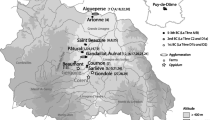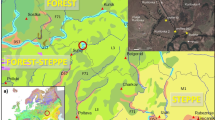Abstract
The introduction and development of cultivation in eastern Finland was studied by pollen and charcoal analysis of a palaeomagnetically dated sediment profile from Lake Orijärvi, in the vicinity of permanent prehistoric fields. The earliest changes of possibly anthropogenic origin are visible in the pollen data from 1630 b.c. onwards and indications of human impact become more evident from 500 b.c. onwards. According to finds of cereal pollen and AMS-dating of charred cereal grains from the oldest field layer, the onset of cultivation can be dated to the Merovingian period around a.d. 600. To a significant extent the pollen data reflect only the cultivation of Secale during the first 600 years. The marked intensification of agricultural activities including cultivation in permanent fields only becomes evident in the pollen data from about a.d. 1050 to 1080 onwards and the most intensive land use phase dates to a.d. 1300–1965. Archaeological and palaeoecological material indicate that swidden cultivation and permanent field cultivation were in use simultaneously during the late Iron Age. The combination of these techniques together with animal husbandry and hunting formed a subsistence strategy in the climatic border-zone outside the centres of the agricultural core areas.






Similar content being viewed by others
References
Bakels CC (2000) Pollen diagrams and prehistoric fields: the case of Bronze Age Haarlem, the Netherlands. Rev Palaeobot Palynol 109:205–218
Behre KE (1981) The interpretation of anthropogenic indicators in pollen diagrams. Pollen Spores 23:225–245
Bennett KD, Willis KJ (2001) Pollen. In: Smol JP, Birks HJB, Last WM (eds) Tracking environmental change using lake sediments, vol 3. Kluwer, Dordrecht, pp 5–32
Berglund BE, Ralska-Jasiewiczowa M (1986) Pollen analysis and pollen diagrams. In: Berglund BE (ed) Handbook of Holocene palaeoecology and palaeohydrology. Wiley, Chichester, pp 455–485
Birks HJB, Line JM (1992) The use of rarefaction analysis for estimating palynological richness from quaternary pollen-analytical data. Holocene 2:1–10
Björck S (1995) A review of the history of the Baltic Sea, 13.0–8.0 ka BP. Quat Int 27:19–40
Broström A, Gaillard MJ, Ihse M, Odgaard B (1998) Pollen-landscape relationships in modern analogues of ancient cultural landscapes in southern Sweden—a first step towards quantification of vegetation openness in the past. Veg Hist Archaeobot 7:189–201
Broström A, Sugita S, Gaillard MJ (2004) Pollen productivity estimates for the reconstruction of past vegetation cover in the cultural landscape of southern Sweden. Holocene 14:368–381
Bunting MJ (2002) Detecting woodland remnants in cultural landscapes: modern pollen deposition around small woodlands in northwest Scotland. Holocene 12:291–301
Calcote R (1995) Pollen source area and pollen productivity: evidence from forest hollows. J Ecol 83:591–602
Erdtman G, Berglund B, Praglowski J (1961) An introduction to Scandinavian pollen flora. Grana Palynol 2:3
Fægri K, Iversen J (1989) Textbook of pollen analysis, 4th edn. In: Faegri K, Kaland PE, Krzywinski K (eds). Wiley, New York
Gaillard MJ, Birks HJB, Emanuelsson U, Berglund BE (1992) Modern pollen/land-use relationships as an aid in the reconstruction of past land-uses and cultural landscapes: an example from south Sweden. Veg Hist Archaeobot 1:3–17
Grimm EC (1991) TILIA and TILIA-GRAPH. Illinois State Museum, Springfield
Grönlund E (1995) A palaeoecological study of land-use history in east Finland. PhD thesis, University of Joensuu. Publ Sci 31:1–44
Haavisto-Hyvärinen M, Rainio H (1991) Geologic map of Finland 1:100 000, map of quaternary deposits, sheet 3142 (Mikkeli), Geological Survey of Finland, Espoo
Håkanson L, Jansson M (1983) Principles of lake sedimentology. Springer, Berlin
Hall VA (1989) A study of the modern pollen rain from a reconstructed 19th century farm. Ir Nat J 23:3
Heikinheimo O (1915) The effects of slash-and-burn cultivation on Finnish forests (in Finnish with German summary). Acta Forestalia Fennica 4:1–264
Hicks S, Birks HJB (1996) Numerical analysis of modern and fossil pollen spectra as a tool for elucidating the nature of fine-scale human activities in Boreal areas. Veg Hist Archaeobot 5:257–272
King J, Peck J (2001) Use of paleomagnetism in studies of lake sediments. In: Last WM, Smol JP (eds) Tracking environmental change using lake sediments, vol 1. Kluwer, Dordrecht, pp 371–389
Linkola K (1916) Studien über den Einfluss auf die Flora in der Gegenden nördlich vom Ladogasee I. Acta Soc pro Fauna et Flora Fenn 45:1–485
Linkola K (1921) Studien über den Einfluss auf die Flora in der Gegenden nördlich vom Ladogasee II. Acta Soc pro Fauna et Flora Fenn 45:1–491
Mikkola E, Talvio T (2000) A silver coin hoard from Orijärvi, Kihlinpelto in Mikkeli rural Commune, Province of Savo, Eastern Finland. Fennoscandia archaeologica 16:129–138
Moore PD, Webb JA, Collison ME (1991) Pollen analysis. Oxford University Press, Oxford
Nielsen AB, Sugita S (2005) Estimating relevant source area of pollen for small Danish lakes around AD 1800. Holocene 15:1006–1020
Ojala AEK (2001) Varved lake sediments in southern and central Finland: long varve chronologies as a basis for Holocene paleoenvironmental reconstructions. PhD thesis, Geological Survey of Finland, Miscellaneous Publications
Ojala AEK, Saarnisto M (1999) Comparative varve counting and magnetic properties of the 8400-yr sequence of an annually laminated sediment in Lake Valkiajärvi, Central Finland. J Paleolimnol 22:335–348
Ojala AEK, Saarinen T (2002) Palaeosecular variation of earth’s magnetic field during the last 10,000 yrs based on the annually laminated sediment of Lake Nautajärvi, central Finland. Holocene 12:391–400
Ojala AEK, Tiljander M (2003) Testing the fidelity of sediment chronology: comparison of varve and paleomagnetic results from Holocene lake sediments from central Finland. Quat Sci Rev 22:1787–1803
Ojala AEK, Saarinen T, Salonen VP (2000) Preconditions for the formation of annually laminated lake sediments in southern and central Finland. Boreal Environ Res 5:243–255
Palo J (2001) Auranjälkiä Asikkalan Kalkkisista. Kentältä poimittua 5—kirjoitelmia arkeologian alalta. [Ploughing marks from Asikkala Kalkkinen] Museoviraston arkeologian osaston julkaisuja 9, pp 99–104
Pitkänen A (1999) Palaeoecological study of the history of forest fires in eastern Finland. PhD thesis, University of Joensuu. Publications in Sciences no.58
Putkinen S, Saarelainen J (1998) Kullenbergin näytteenottimen uusi kevennetty malli [A lighter model of Kullenberg’s sampler]. Geologi 50:22–23
Reille M (1992) Pollen et spores d’Europe et d’Afrique du nord. Laboratoire de botanique historique et palynologie, Marseille
Reille M (1995) Pollen et spores d’Europe et d’Afrique du nord. Supplement 1. Laboratoire de botanique historique et palynologie, Marseille
Reimer PJ, Baillie MGL, Bard E, Bayliss A, Beck JW, Bertrand C, Blackwell BG, Buck CE, Burr G, Cutler KB, Damon PE, Edwards RL, Fairbanks RG, Friedrich M, Guilderson TP, Hughen KA, Kromer B, McCormac FG, Manning S, Bronk Ramsey C, Reimer RW, Remmele S, Southon JR, Stuiver M, Talamo S, Taylor FW, van der Plicht J, Weyhenmeyer CE (2004) IntCal04 Terrestrial radiocarbon age calibration, 26–0 ka BP. Radiocarbon 46:1029–1058
Roeck Hansen B, Nissinaho A (1995) A Fossil Landscape in Salo, Laitila, SW Finland. Karhunhammas 16:41–52
Saarnisto M (1970) The late weichselian and flandrian history of the saimaa lake complex. Soc Sci Fenn Comment Phys Math 37:1–107
Saarnisto M (2000) Shoreline displacement and emergency of lake basins. In: Pajunen H (ed) Carbon in Finnish lake sediments. Geological survey of Finland, special paper 29, pp 25–34
Saarnisto M, Saarinen T (2001) Deglaciation chronology of the Scandinavian ice sheet from the Lake Onega Basin to the Salpausselkä end moraines. Glob Planet Change 31:387–405
Sarmaja-Korjonen K (1992) Fine-interval pollen and charcoal analyses as tracers of early clearance periods in S Finland. Acta Bot Fenn 146:1–75
Sasuramo M (1923) Studies on quaternary varve sediments in southern Finland. Bulletin Commission géologique Finlande 60:164–164
Sauramo M (1929) The quaternary geology of Finland. Bulletin Commission géologique Finlande 86:1–1s10
Simonen A, Niemelä R (1980) Geologic map of Finland 1:100 000, map of pre-quaternary rocks, sheet 3142 (Mikkeli), Geological Survey of Finland
Snowball I, Sandgren P (2001) Application of mineral magnetic techniques to paleolimnology. In: Last WM, Smol JP (eds) Tracking environmental change using lake sediments, vol 2. Kluwer, Dordrecht, pp 217–237
Soininen AM (1974) Old traditional agriculture in Finland in the 18th and 19th centuries. (in Finnish with English summary). J Sci Agric Soc Finl 46:1–459
Stockmarr J (1971) Tablets with spores used in absolute pollen analysis. Pollen Spores 13:615–621
Stuiver M, Reimer PJ (1993) Extended 14C data base and revised CALIB 3.0 14C age calibration program. Radiocarbon 35:215–230
Sugita S (1993) A model lf pollen source area for an entire lake surface. Quat Res 29:239–244
Sugita S (1994) Pollen representation of vegetation in quaternary sediments: theory and method in patchy vegetation. J Ecol 82:881–897
Sugita S, Gaillard MJ, Broström A (1999) Landscape openness and pollen records: a simulation approach. Holocene 9:409–421
Taavitsainen JP (1987) Wide-range hunting and swidden cultivation as prerequisites of iron age colonization in Finland. Suom antropol 12:213–233
Taavitsainen JP, Simola H, Grönlund E (1994) Cultivation history beyond the periphery: early agriculture in the north European boreal forest. J World Prehist 12:199–253
Thompson R, Oldfield F (1986) Environmental magnetism. Allen and Unwin, London
Tolonen K (1983) The post-glacial fire record. In: Ross W, MacLean DA (eds) The role of fire in northern circumpolar ecosystems. Wiley, New York, pp 21–44
Tolonen K (1986) Charred particle analysis. In: Berglund BE (ed) Handbook of Holocene palaeoecology and palaeohydrology. Wiley, Chichester, pp 485–496
Vasari Y, Glückert G, Hicks S, Hyvärinen H, Simola H, Vuorela I (1996) Finland. In: Berglund BE, Birks HJB, Ralska-Jasiewiczowa M, Wright HE (eds) Palaeoecological events during the last 15, 000 years: regional syntheses of palaeoecological studies of lakes and mires in Europe. Wiley, Chichester, pp 281–351
Vikkula A, Seppälä SL, Lempiäinen T (1994) The ancient field of Rapola. Fennoscandia archaeologica 11:41–59
Vuorela I (1973) Relative pollen rain around cultivated fields. Acta Bot Fenn 102:1–27
Vuorela I (1980) Microspores of Isoetes as indicators of human settlement in pollen analysis. Acta Soc Fauna Flora Fenn 56:13–19
Vuorela I (1986) Palynological and historical evidence of slash-and-burn cultivation in south Finland. In: Behre KE (ed) Anthropogenic indicators in pollen diagrams. Balkema, Rotterdam, pp 53–64
Walanus A, Nalepka D (1999) POLPAL. Program for counting pollen grains, diagram plotting and numerical analysis. Acta Palaeobotanica Suppl 2:659–661
Whitlock C, Larsen C (2001) Charcoal as a fire proxy. In: Smol JP, Birks HJB, Last WM (eds) Tracking environmental change using lake sediments, vol 2. Kluwer, Dordrecht, pp 75–97
Acknowledgements
The pollen analytical part of this study was financed by a scientific grant from the Finnish Cultural Foundation. We sincerely thank Tanja Tenhunen for the macrofossil analyses, and Kari Hjelle and an anonymous reviewer for the comments of the manuscript. The Geological Survey of Finland provided facilities for pollen analysis.
Author information
Authors and Affiliations
Corresponding author
Additional information
Communicated by B. Aaby.
Rights and permissions
About this article
Cite this article
Alenius, T., Mikkola, E. & Ojala, A.E.K. History of agriculture in Mikkeli Orijärvi, eastern Finland as reflected by palynological and archaeological data. Veget Hist Archaeobot 17, 171–183 (2008). https://doi.org/10.1007/s00334-007-0099-5
Received:
Accepted:
Published:
Issue Date:
DOI: https://doi.org/10.1007/s00334-007-0099-5




